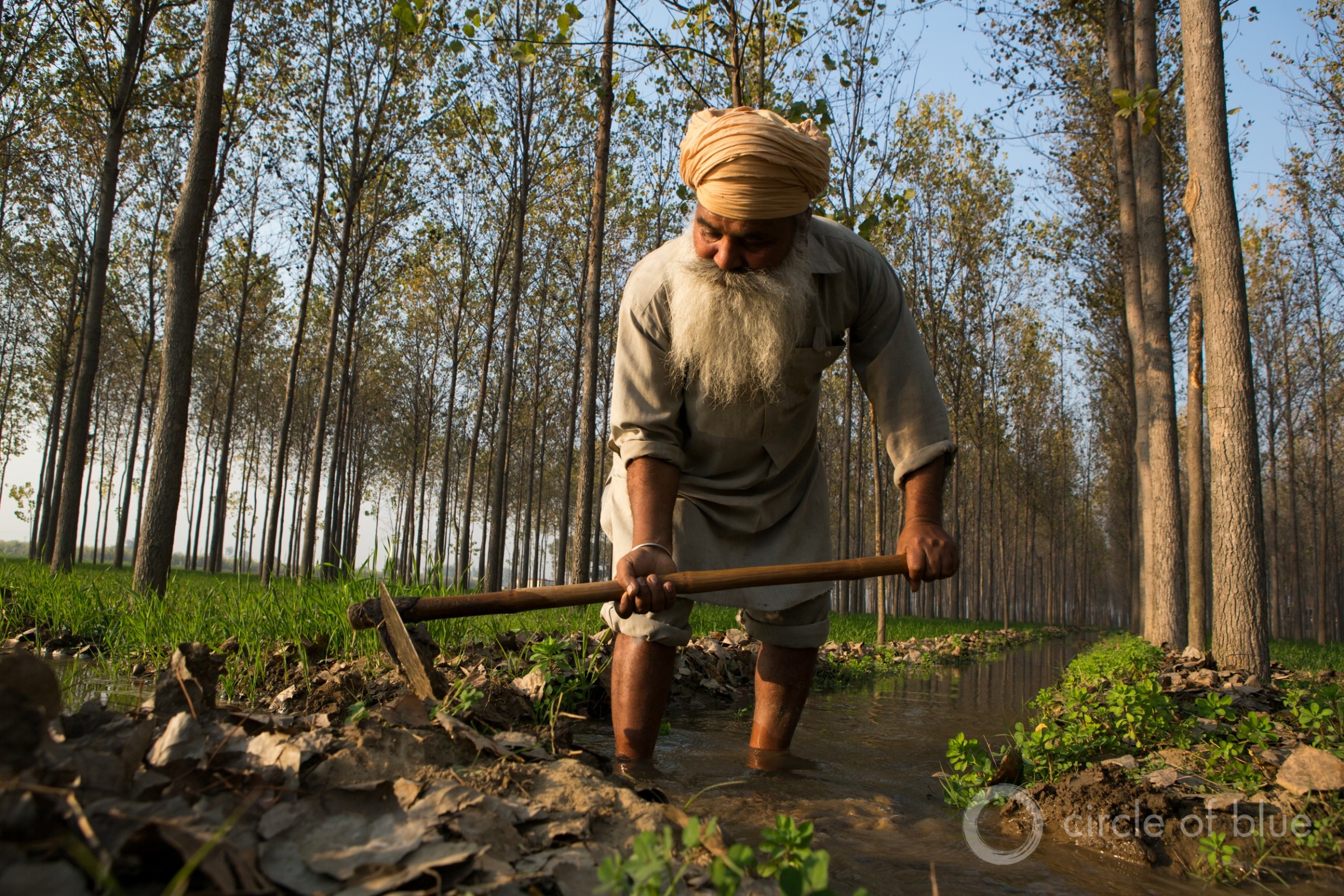The Stream, July 24, 2024: As Italy’s Po River Delta Sinks into Adriatic Sea, Freshwater Ecosystems and Farmland Disappear

Desraj Khai works paddies of rice and wheat that grow beneath stands of aspen in India’s northwestern state of Punjab. Photo © J. Carl Ganter/Circle of Blue
YOUR GLOBAL RUNDOWN
- In northern Italy, subsidence — the sinking of land over time — is allowing the Po River watershed to be overcome by the salty Adriatic Sea, submerging habitat and farmland.
- After years of crisis, Northern Ireland’s leaders agree to an action plan to save the polluted Lough Neagh, which supplies 40 percent of the country’s drinking water.
- Recent studies show that increased carbon in the atmosphere is making the world’s dryland habitats more lush, raising concerns over strained water supplies.
- Severe rainfall in southwestern Ethiopia has weakened a hilltop beside a village, triggering a landslide that has killed more than 200 people.
More than one year after a mining waste spill inundated the waterways of Fort Chipewyan and Fort McKay with toxic metals, communities around Alberta, Canada, continue to wait for cleanup and answers.
“We still utilize our land, we still utilize our water, we still continue to harvest fish… to feel those types of impacts, especially an impact like [the Kearl spill and ongoing seepage], that really impacts who we are as First Nations people, impacts our relationality with our land and our water.” — Melaine Dene, acting director of the Mikisew Cree First Nation’s department of government and industry relations.
Two separate toxic spills within the past two years have left First Nations communities living along the Athabasca River unsure of the quality of the water they drink, swim in, and fish from, Mongabay reports. A nine month-long seepage of mining waste into local groundwater reserves, coupled with a 1.4 million gallon overflow of tailings last year into the Lake Athabasca watershed, has spurred sadness and frustration.
Canada’s tar sands are the fourth-largest oil deposit in the world, and the tailings ponds continue to grow. Currently, there is no approved method for reclaiming tar sands wastewater. The threat to human health and biodiversity on these lands and waters is a top concern for the communities. “Their sort of conclusion is, ‘Do we matter? Do we exist in the minds of people that are saying this?’” John O’Connor, who was a family physician in Fort Chipewyan from 2003 to 2007, tells Mongabay. “The anxiety is palpable.”
In March, the Athabasca Chipewyan First Nation sued the Alberta Energy Regulator for its mismanagement and poor oversight. The case is ongoing.
— Christian Thorsberg, Interim Stream Editor
Recent WaterNews from Circle of Blue
- Climate Change Drains Reservoirs in the U.S. — Amid July’s record-breaking temperatures, California’s largest reservoir lost an estimated 4.1 billion gallons of water, due to evaporation.
- Hurricane Beryl: A Sign of Increasingly Severe Storms — NOAA predicted an 85 percent chance of an above-normal hurricane season for 2024, attributing the increased strength of storms like Beryl and those to follow to warming oceans.
The Lead
The Po River wetlands of northern Italy have for generations supplied freshwater channels and habitat for rice farmers and hake fishers, supporting their livelihoods and the region’s natural beauty. But over the past half-century, the delta has become nearly unrecognizable. Entire stretches of the coast and its freshwater bodies have sunk below sea level — in some cases, dipping 10 feet or more — and into the Adriatic Sea, Al Jazeera reports.
This sinking, known as subsidence, has combined with saltwater intrusion to alter the delta’s freshwater, landscape, and lifeways. Climate change-induced drought, erratic rainfall, and the overuse of water have all been attributed to the loss.
Where the sea meets the river, a salt wedge has formed in recent years. In a particularly rainless 2022, the wedge pushed 25 miles inland. Last year, with more rain, the wedge extended 10 miles. Roughly 70 percent of the 54-square-mile delta is agricultural land. The wedge is increasing the area’s soil salinity, “altering the structure of the soil and the activity of the microorganisms that populate it, making it unusable for growing rice,” according to Al Jazeera.
“In two years, the area of land which can be cultivated in the district of Polesine has reduced by more than 30 percent, according to a 2022 report from Coldiretti, an agricultural producers’ association.”
Farmers are losing thousands of pounds of rice each year to the effects of subsidence, prompting local action. Barriers have been built to protect the Po, but even this infrastructure is losing its effectiveness in some areas, as the river level drops lower.
In context: Saltwater Intrusion, a ‘Slow Poison’ to East Coast Drinking Water
This Week’s Top Water Stories, Told In Numbers
40
Percent of Earth’s surface that is covered by drylands, an ecosystem known for dry woodlands and savanna grass, and being prone to high temperatures and wildfire. But these regions — including southern Australia, the African Sahel, northern China, and western India — are “defying meteorology and becoming greener,” rather than desertifying, Yale Environment 360 reports. An increase of carbon dioxide in the atmosphere is allowing plants to photosynthesize more efficiently, while requiring less water. Taking advantage of this phenomenon, some growers are turning these dry landscapes into green fields. Seeking to irrigate these crops — using water at the expense of wildlife and native, arid desert plants — could have long-term effects on groundwater availability in these areas, scientists caution.
229
Number of people in southwestern Ethiopia, as of Tuesday morning, who died after days of heavy rainfall triggered a devastating landslide onto a Geze district village, Reuters reports. The Horn of Africa, thanks to the tail end of the El Niño weather phenomenon, has been subject to severe rainfall for much of this year, and its people have suffered. From March to May, roughly 293,000 people in Kenya, and 200,000 people in Tanzania were pushed from their homes, as hundreds of people died.
On the Radar
The United Kingdom’s largest lake, Lough Neagh, which supplies 40 percent of Northern Ireland’s drinking water, has for years been sullied by toxic algal blooms, the result of high phosphorus and nitrogen concentrations from agricultural runoff, sewage discharge, and septic tanks. Finally, Northern Ireland’s leaders have agreed to a new plan to address the lake’s health, the Guardian reports. The project includes pollution reduction, tree planting, water-quality monitoring, and a review of sand extraction from the lake.
More Water News
Idaho Farmers: Farmers along the Snake River watershed saw their irrigation needs go unfulfilled as groundwater shortages forced a curtailment order — which could become the norm if aquifers throughout the state continue to be depleted, Inside Climate News reports.
Oklahoma’s Tribal Lands: A recent study from the University of Oklahoma has found that tribal lands in Oklahoma are five times more likely than the rest of the state to flood, Grist reports.
Christian Thorsberg is an environmental writer from Chicago. He is passionate about climate and cultural phenomena that often appear slow or invisible, and he examines these themes in his journalism, poetry, and fiction.







Leave a Reply
Want to join the discussion?Feel free to contribute!